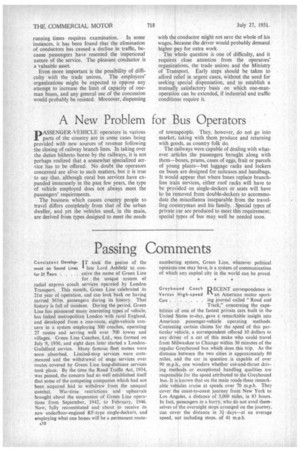Passing Comments
Page 32

Page 33

If you've noticed an error in this article please click here to report it so we can fix it.
Consistent DevelopIT took the genius of the merit on Sound Lines late Lord Ashfield to con
for 21 tears . . . ceive the name of Green Line
for the unique system of radial express coach services operated by London Transport. This month, Green Line celebrated its 21st year of operation, and can look back on having carried 365m. passengers during its history. That history is full of incident. During the period, Green Line has pioneered many interesting types of vehicle, has linked metropolitan London with rural England, and developed from a one-route, eight-vehicle concern to a system employing 300 coaches, operating 27 routes and serving well over 700 towns and villages. Green Line Coaches, Ltd., was formed on July 9, 1930, and eight days later started a LondonGuildford service. Many famous fleet names were soon absorbed. Limited-stop services were commenced and the withdrawal of stage services over routes covered by Green Line long-distance services took place. By the time the Road Traffic Act, 1934, was passed, the concern had so well established itself that some of the competing companies which had not been acquired had to withdraw from the unequal combat. War-time restrictions and upheavals brought about the suspension of Green Line operations from September, 1942, to February, 1946. Now fully reconstituted and about to receive its new underfloor-engined RF-type single-deckers, and employing what one hopes will be a permanent route
A30 numbering system, Green Line, whatever political • opinions one may have, is a system of communication of which any capital city in the world can be proud. •
Greyhound Coach RECENT correspondence in Versus 1-ligh-speed "an American motor sport Cars ing journal called "Road and Track," concerning the capabilities of one of the fastest private cars built in the United States to-day, gave a remarkable insight into American passenger-vehicle operating methods. Contesting certain claims for the speed of this particular vehicle, a correspondent offered 10 dollars to any driver of a car of this make who could travel from Milwaukee to Chicago within 30 minutes of the regular Greyhound bus which does this trip. As the distance between the two cities is approximately 80 miles, and the car in question is capable of over 90 m.p.h., one wonders whether cut-and-thrust driving methods or exceptional handling qualities are responsible for the speed attributed to the Greyhound bus. It is known that on the main roads these remarkable vehicles cruise at speeds over 70 m.p.h. They cover the coast-to-coast journey from New York to Los Angeles, a distance of 3,000 miles, in 83 hours. In fact, passengers in a hurry, who do not avail themselves of the overnight stops arranged on the journey, can cover the distance in 3i days—at an average speed, not including stops, of 41 m.p.h. Bright Ideas Are IN "The Commercial Motor" Not a Continental PreI dated April 27 an Italian rogatIve method of saving tongued and grooved flooring was described. Visiting the workshops of Thomas Tilling (B.T.C.), Ltd., recently, a member of our staff noticed an even more interesting system in use in the bodybuilding section. Ordinary planks are used for flooring goods vehicles, the chassis being first laid with longitudinal T-section steel members On these the flat timbers are laid, the vertical section of the T lying between adjacent planks. The steel members can be arranged to stand proud of the floor to give protection to the floor and to facilitate the sliding of goods along it.
Do You Receive " 1I•1 large offices it is worth Your Visitors Like 1-while having one or more This? girl ushers. . . . It is hardly
necessary to give a specification of the qualities desirable in them, except to say that they are generally lacking in an office boy," This advice is contained in a booklet recently published by Tube Investments, Ltd., which is to be more widely issued through the British Association for Commercial and Industrial Education, London, W.I. Written in the litotes style, as witness the passage above, the publication conveys its message with effect. Review would not be so descriptive as quotation. "'The sweetest sound in any man's ear is the sound of his own name,' and you will notice when you meet an American that he takes pains to ensure that he registers yours.... How sadly different the average Englishman, who at the moment of introduction is busy thinking, What a ghastly tie.'" Regarding Government officials, the booklet says: "Common prudence reinforces the dictates of good manners. Even when remarks about Jacks-inoffice," red tape' or ' Gestapo ' would be completely apposite, the relief which they would give to your feelings must be outweighed by the knowledge that there is no individual or company completely lawabiding in a controlled economy." As frequent visitors to factories we would commend this booklet, "A Guide to the Proper Treatment of Factory Visitors," for widespread study.
Those Who Live in 1(ELETONS have a habit Glass Houses Need '—' of breaking out of the
Blinds most securely locked cup
boards. For instance, during luncheon, a representative of "The Commercial Motor" received from the transport manager of a biscuit company an emphatic dissertation on the best way to run a fleet to distribute biscuits with the maximum economy and efficiency. It was all most convincing until the waiter brought the cheese and biscuits, with the profound apology, "I'm terribly sorry, sir, but the biscuits were broken in the van, but they are quite fresh." The name on them was embarrassingly familiar.






























































































